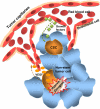Turning cancer stem cells inside out: an exploration of glioma stem cell signaling pathways
- PMID: 19286664
- PMCID: PMC2719304
- DOI: 10.1074/jbc.R900013200
Turning cancer stem cells inside out: an exploration of glioma stem cell signaling pathways
Abstract
Tumors are complex collections of heterogeneous cells with recruited vasculature, inflammatory cells, and stromal elements. Neoplastic cells frequently display a hierarchy in differentiation status. Recent studies suggest that brain tumors have a limited population of neoplastic cells called cancer stem cells with the capacity for sustained self-renewal and tumor propagation. Brain tumor stem cells contribute to therapeutic resistance and tumor angiogenesis. In this minireview, we summarize recent data regarding critical signaling pathways involved in brain tumor stem cell biology and discuss how targeting these molecules may contribute to the development of novel anti-glioma therapies.
Figures


References
-
- Cho R. W., Clarke M. F. ( 2008) Curr. Opin. Genet. Dev. 18, 48– 53 - PubMed
-
- Singh S. K., Hawkins C., Clarke I. D., Squire J. A., Bayani J., Hide T., Henkelman R. M., Cusimano M. D., Dirks P. B. ( 2004) Nature 432, 396– 401 - PubMed
-
- Bao S., Wu Q., McLendon R. E., Hao Y., Shi Q., Hjelmeland A. B., Dewhirst M. W., Bigner D. D., Rich J. N. ( 2006) Nature 444, 756– 760 - PubMed
Publication types
MeSH terms
Substances
Grants and funding
LinkOut - more resources
Full Text Sources
Other Literature Sources
Medical

